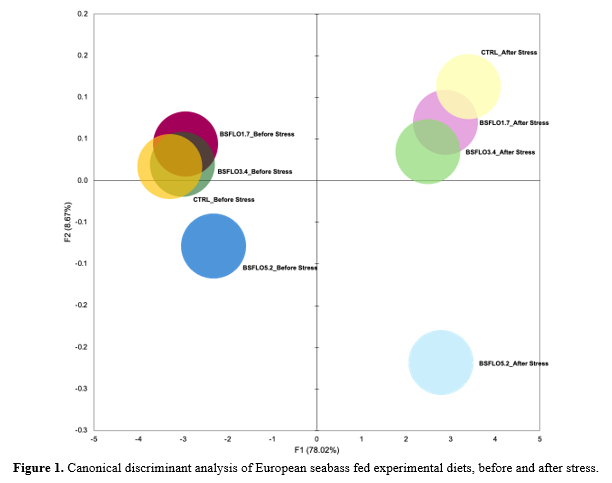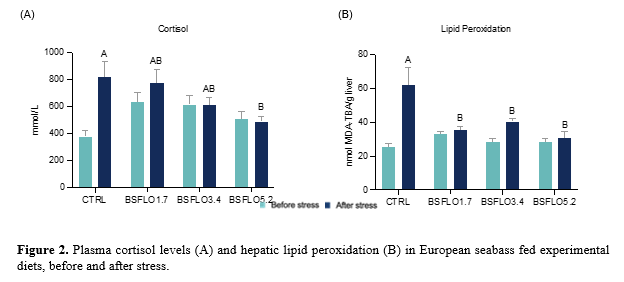BLACK SOLDIER FLY LARVAE OIL AS A FUNCTIONAL INGREDIENT FOR EUROPEAN SEABASS JUVENILES: RESPONSE TO AN ACUTE STRESS CHALLENGE
Introduction
Black soldier fly (BSFLO), a by-product of insect meal processing, is characterized by presenting high levels of lauric acid (30-40%), a fatty acid suggested to enhance hepato-metabolic status. Additionally, when sourced from larvae-fed vegetable wastes rich in tocopherols, BSFLO also presents significant levels of these antioxidant compounds. Stress in aquaculture fish, often triggered by factors such as overcrowding, poor water quality, or sudden environmental changes, can significantly impair their immune function, growth rates, and overall welfare. This underscores the critical need for feeding strategies that not only meet the nutritional requirements but also help mitigate stress. Therefore, this study aims to appraise the impact of BSFLO dietary inclusion on the metabolic and oxidative response of European seabass (Dicentrarchus labrax) juveniles – a key species in Mediterranean aquaculture – following an acute stress challenge.
Material and methods
A control diet (CTRL) was formulated with 6% fish oil and 5% poultry oil (PO). Three other experimental diets were formulated to include 1.7%, 3.4% and 5.2% of BSFLO, supplied by Entrogreen® - Ingredient Odissey S.A. (BSFLO1.7, BSFLO3.4 and BSFLO5.2, respectively), at the expense of PO. Each diet was assigned to triplicate homogeneous groups of 50 fish (11 ± 0.1 g) that were fed until apparent satiation three times daily for 12 weeks. Fish were subjected to a 12-hour light/12-hour dark photoperiod regime and kept in a recirculating saltwater system (35‰, 23 ± 1 °C). By the end of the trial, 5 fish per tank (15 per dietary treatment) were sampled for analysis of metabolic and oxidative stress response-related parameters, and other 5 fish per tank were exposed to an acute stress episode consisting of 1 min air exposure and 14 min overcrowding (100 kg/m3) followed by 90 min of recovery before sampling. Plasma cortisol levels, along with plasmatic and hepatic metabolites (e.g., glucose, lactate, triglycerides, among others) were quantified. Additionally, lipid peroxidation and the activity of oxidative stress-related enzymes (e.g., superoxide dismutase, catalase, and glutathione peroxidase, and others) were measured. Growth performance and feed efficiency were also evaluated.
Results
The experimental diets ensured a 100% survival rate, and no behavioural alterations were observed in the fish throughout the 12-week feeding trial. Fish fed the BSFLO5.2 diet achieved the highest final body weight and the lowest feed conversion ratio (FCR). A clear response to acute stress was observed, as indicated by significantly increased levels of plasmatic cortisol, glucose and lactate, as well as lipid peroxidation products in the liver of fish sampled after the acute stress challenge. Based on the Mahalanobis distance between group centroids, fish fed BSFLO5.2 diet were clustered at a significant distance from the other groups either before or after stress challenge (Fisher’s p-value < 0.0001), with this separation being particularly prominent between the BSFLO5.2 and CTRL groups (Figure 1). Indeed, based on the two-way ANOVA, fish fed BSFLO5.2, specifically after the stress challenge, exhibited significantly lower (Tukey’s p-value < 0.05) plasma cortisol (Figure 2-A) and cholesterol levels than those fed CTRL. Additionally, BSFLO5.2 group also had significantly lower lipid peroxidation (LPO)(Figure 2-B) and superoxide dismutase (SOD) activity compared to CTRL. Glutathione peroxidase (GPx) activity was also the lowest in seabass fed BSFLO5.2, regardless of stress condition. Although without statistically significance, stressed fish fed BSFLO5.2 also have lower levels of plasma glucose, lactate, and triglycerides, as well as hepatic cholesterol, non-esterified fatty acids (NEFA), and catalase (CAT) activity compared to CTRL-fed fish.
Discussion and conclusions
European seabass juveniles fed the BSFLO5.2 diet exhibited a marked reduction in cortisol levels - the primary indicator of stress - as well as decreased plasma cholesterol, its metabolic precursor. This attenuation of the stress response can be associated with reduced activation of key antioxidant enzymes, including SOD and GPx, and lower levels of LPO, suggesting diminished oxidative stress. In addition to these physiological benefits, the 5.2% inclusion of BSFLO significantly enhanced growth performance and feed efficiency. Together, these findings indicate that BSFLO, particularly when included at 5.2%, can modulate stress-related pathways while supporting optimal growth in European seabass juveniles, highlighting its potential as a functional ingredient in aquafeeds.
Acknowledgments
This work has been supported by InsectERA Mobilizing Agenda (PRR - InsectERA - The ERA of the insect industry), funded by Portugal and European Union - NextGenerationEU, with the identifier C644917393-00000032. Strategic Projects UIDB/05748/2020 and UIDP/05748/2020 funded by FCT.

